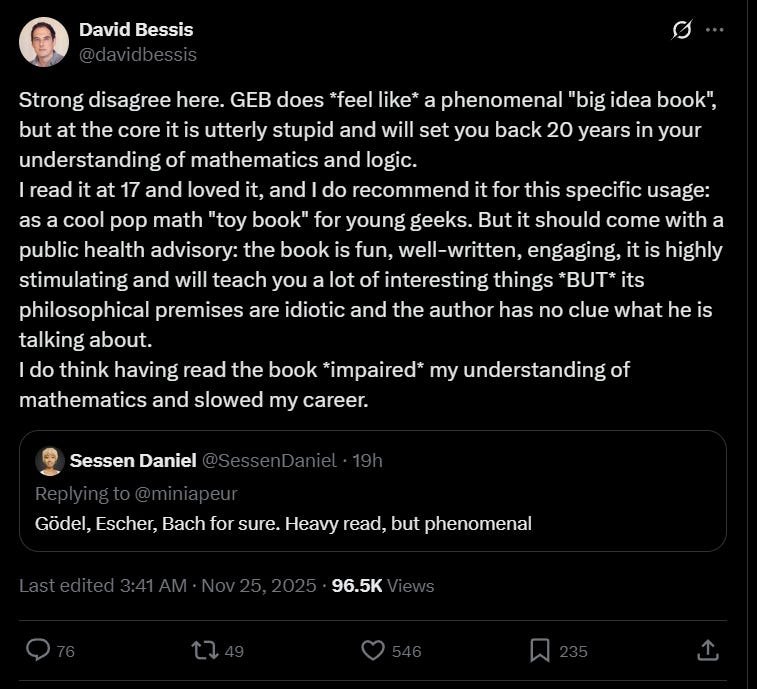Defending GEB
Why Gödel, Escher, Bach Still Shapes System Builders
Introduction
Gödel, Escher, Bach is more than a celebrated artifact of late‑20th‑century intellectual culture. It is a conceptual catalyst—a generator of models, analogies, and recursive structures that reshapes how its readers think about thinking. For some, this makes the book dangerous or misleading. But for those who understand its genre correctly, GEB acts as an accelerant: it ignites the desire to explore the deep architecture of cognition, agency, and formal systems. Its value lies not in its mathematical rigor, but in its power to reorganize a mind.
A Category Error in Criticism
Most harsh critiques of GEB, including the recent viral denunciations, suffer from a simple misclassification. They treat Hofstadter’s book as if it were intended to teach formal logic, computability, or philosophy with textbook precision. Evaluated that way, GEB will always seem sloppy or misguided. But this framing is incorrect. GEB is not a textbook. It is a conceptual atlas—an exploration of self‑reference, recursion, and meaning‑making across mathematics, music, art, and cognition.
The book builds intuition, not theorems. It invites curiosity, rather than prescribing a curriculum. And this distinction matters: when critics blame GEB for not producing logicians, they blame a microscope for not being a telescope.
What GEB Actually Does Well
GEB excels at revealing structural isomorphisms between domains that usually remain separate. Bach’s canons, Escher’s impossible prints, and Gödel’s arithmetization of syntax become variations of the same recursive principle. This cross‑domain resonance is the book’s central achievement. Hofstadter shows that meaning emerges from patterns that loop back on themselves—that recursion is not merely a trick of arithmetic but a generative mechanism of mind.
Readers attuned to this level of abstraction quickly discover that the book is not explaining consciousness so much as modeling the style of explanation consciousness requires.
The Constructive Reader
The strongest defenders of GEB are always the builders. They are the ones who read it not as a compendium of answers but as a demonstration of how to construct frameworks. For these readers, GEB becomes a formative blueprint for later intellectual architecture: theories of agency, identity, formal systems, self‑reference, or emergent cognition.
This pattern is so consistent it borders on a demographic law. The book disproportionately influences those who will eventually build conceptual systems themselves. It inspires system‑level thinkers: engineers of ideas, not merely consumers of them.
The Personal Lineage
In my own trajectory, GEB played exactly this catalytic role. It was one of the key motivations for leaving a well‑paid engineering position at HP to pursue a graduate degree in artificial intelligence. The book didn’t teach me logic or computability. It did something more fundamental: it revealed the architecture of deep problems worth devoting a life to. It highlighted the structural unity between recursion, representation, self‑modeling, and cognition. It suggested that intelligence itself might be a recursive, self‑maintaining pattern—an idea that would eventually reappear in my later work on agency, the Quantum Branching Universe, Pattern Identifiers, and Conditionalism.
GEB did not provide these theories. It gave me the conceptual vocabulary from which they could grow.
The Real Weaknesses—Honestly Conceded
A proper defense of GEB must acknowledge its shortcomings. Hofstadter often overextends analogies into arguments. He oversells the explanatory depth of strange loops. His discussions of AI are dated, and his treatment of Gödel’s theorem is more poetic than formal. But these are flaws of an ambitious synthesizer, not a careless thinker. They stem from the attempt to integrate mathematics with phenomenology, recursion with consciousness, and formal systems with meaning.
The book’s errors are generative errors—the kind that push a reader to clarify, refine, and eventually surpass the original argument.
Why the Criticisms Miss
The viral claim that GEB “sets you back twenty years” is a confession of misuse. If someone tries to learn math from metaphor, they will be misled. If someone expects a popular exposition to substitute for formal training, disappointment is inevitable. But this is not a flaw in the book. It is a flaw in the expectation.
GEB is not an instructional text. It is an invitation. It asks you to explore the strange relationship between formal structure and emergent meaning. Those who approach it as such gain a lifelong cognitive tool. Those who treat it as a logic textbook misunderstand the genre entirely.
The Axio Perspective
From the standpoint of Axio, the defense of GEB becomes especially clear. GEB models the constructive process by which coherence emerges from chaotic substrate. It reveals how patterns at different levels mirror one another. It demonstrates how self‑reference becomes agency when embedded within a stable system. And it introduces the idea that identity is a recursive phenomenon—an anticipatory, self‑constraining loop that persists through structural coherence.
In this sense, GEB anticipates central themes of the Axio framework. It is proto‑Coherence, proto‑Conditionalism, proto‑agency. The book does not produce doctrine. It produces the conditions under which doctrine can be invented.
Conclusion
Defending GEB does not mean denying its flaws. It means recognizing its true category: a conceptual catalyst whose influence lies not in the precision of its arguments but in the minds it activates. For many thinkers—including myself—it was the generative spark that made formal reasoning, artificial intelligence, and recursive models of agency feel like living possibilities.
GEB does not tell you what to think. It shows you how to think about thinking. This is its lasting contribution, and its real legacy.



